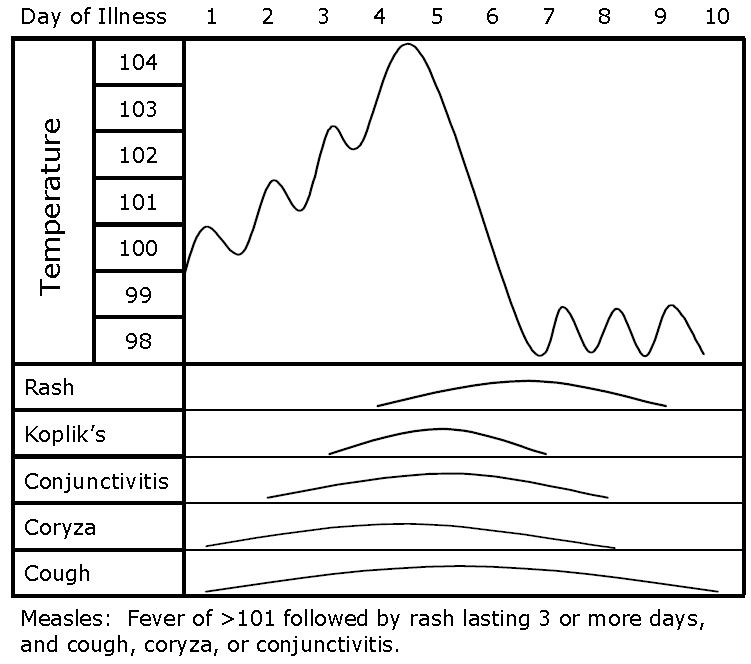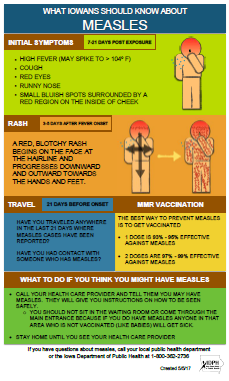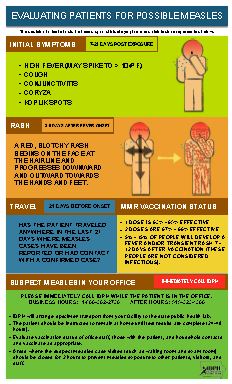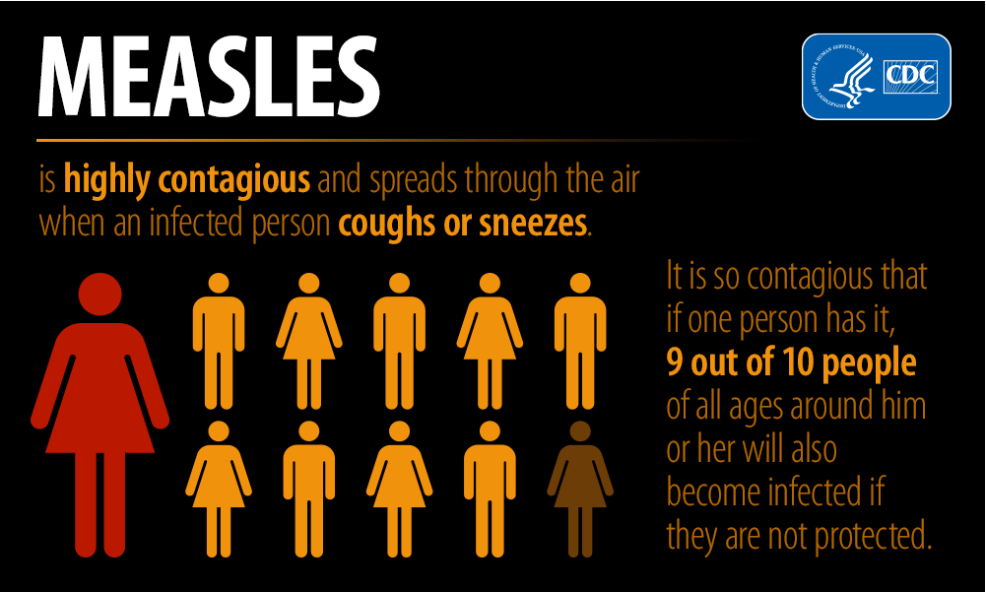Measles (Rubeola)
On this page:
Definition
Measles is a very contagious disease caused by a virus. It spreads through the air when an infected person coughs or sneezes. Measles starts with a cough, runny nose, red eyes, and fever. Then a rash of red bumps and flat spots breaks out. It starts at the head and spreads to the rest of the body.
Before the measles vaccination program started in 1963, an estimated 3 to 4 million people got measles each year in the United States. Of these, approximately 500,000 cases were reported each year to CDC; of these, 400 to 500 died, 48,000 were hospitalized, and 1,000 developed encephalitis (brain swelling) from measles. Since then, widespread use of measles virus-containing vaccine has led to a greater than 99% reduction in measles cases compared with the pre-vaccine era. However, measles is still common in other countries. Unvaccinated people continue to get measles while abroad and bring the disease into the United States and spread it to others.
Measles is reportable to the Iowa Department of Public Health by Iowa Administrative Code 641 IAC 1 .
Symptoms
Signs and symptoms begin to appear about 7-21 days after being infected. The rash usually appears about 14 days after being infected.
- Cough
- Runny nose
- Red, watery eyes
- Nasal congestion
- Fever (higher than 101° F)
- Rash (flat red areas all over the body, with raised bumps )
- Koplik spots (small spots with white or bluish-white centers on the inside of the cheeks)
Symptoms usually worsen for several days and may lead to the following complications:
- Pneumonia
- Swelling in the brain
- Middle ear infection
- Diarrhea
- Death

Causes
Measles is caused by breathing in a virus carried on droplets from other people’s coughs and sneezes and less commonly from objects recently contaminated with infected droplets. Measles is one of the most contagious infections known to exist. People can spread measles for several days before they get the rash until several days after the rash develops.
Risk Factors
It is routine for children to be vaccinated against measles at 12 months and 4 years of age. Those who have not had these two doses of vaccine are at risk for measles. People born before 1957 likely had measles as children and less likely to able to catch measles, but being vaccinated is a good way to be sure. Measles vaccine is one of the most effective vaccines used today.
Prevention
- The best way to prevent measles is to get vaccinated with a measles containing vaccine.
- CDC recommends children get two doses of MMR vaccine, starting with the first dose at 12 through 15 months of ages, and the second dose at 4 through 6 years of age. The MMR vaccine is very safe and effective. Two doses of vaccine are about 97% effective at preventing measles. One dose is about 93% effective.
- Measles vaccine is required for entry into Iowa public and private schools, as well as licensed child care centers and preschools. Following the Iowa requirements on immunization greatly reduces the risk of children catching measles.
- To view the childhood immunization schedule visit CDC’s Immunization Schedules.
- Measles Vaccine Recommendations: Quick Reference Guide (4/29/2019)

Questions regarding MMR vaccination can be directed to:
Shelly Jensen, RN, BSN
Nurse Clinician
1-800-831-6293
Fax: 1-800-831-6292
or use the "Contact Us" page to submit questions online
Treatment
No treatment can get rid of measles once it is established. However, there are actions that can be taken to protect those who have been recently exposed.
- Immune globulin (IG) is sometimes used to treat someone who has been exposed and thought to likely get sick. If given within six days of exposure IG can either prevent the disease or make the symptoms less severe.
- Measles vaccine can be given to unvaccinated people within 72 hours of exposure. The vaccine will either prevent the disease or make symptoms less severe.
Laboratory Testing
Immediately call the Iowa Department of Public Health, Center for Acute Disease Epidemiology at (800) 362-2736 if you suspect measles in a patient. IDPH will assist in determining the appropriate testing to be done based upon the patient history. IDPH will provide a test request form.
Both serology specimen for IgG and specimens for PCR testing may be requested.
- Preferred specimens for SHL Serology IgG testing: Prefer serum (min 500ul) or can send 4-6ml whole blood in a red top or serum separator tube, for infants 2-3ml acceptable and fill out Serology test request form
- Preferred specimens for PCR: Specimens for measles PCR should be obtained within five days of rash onset (0-9 days max). Viral RNA is more likely to be detected when the specimen is collected as soon as possible after rash onset.
Specimen Types Vary:
- On day 0-5 of rash, collect a throat swab*
*If a throat swab cannot be collected, a nasopharyngeal specimen can be sent instead; however, a throat swab is the preferred specimen.
**If date of specimen collection is already more than nine days past rash onset, PCR is not valid.
Collection instructions: PCR
A throat swab is preferred. Nasal/NP swabs or washes are acceptable but not preferred.
Throat swab: Swab tonsillar areas and posterior nasopharynx. Use tongue blade to depress tongue to prevent contamination of swab with saliva. Place swab into 2-3 ml of transport media.
Appropriate swabs and media:
- Dacron swabs, flocked swabs
- Viral transport medium (VTM)

Inappropriate swabs:
- Wood-tipped applicators, Cotton-tipped swabs, Calcium-alginate tipped swabs, Charcoal swabs, Gel swabs
- Dry swabs are not acceptable
Shipping instructions:
Store/ship specimens at refrigeration temperature (2-8°C). IDPH will arrange specimen transport from your facility to SHL.
Statistics
In 2021, there were no cases of measles reported in Iowa. Two cases of measles were confirmed in Iowa in 2019. Prior to this, the last case in Iowa was in 2011.
For more detailed information and statistics on all notifiable diseases, please see our current annual report located in the reports section of the CADE homepage.
Additional Resources
Public

Immunization Action Coalition
The Children’s Hospital of Philadelphia-Vaccine Education Center (CHOP)

Public Health
Schools
Business and Childcare
Health Care Providers

CDC Infographics



